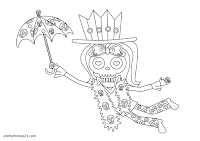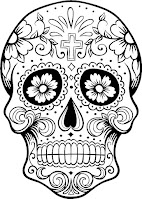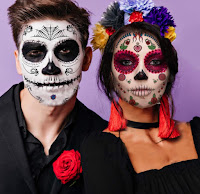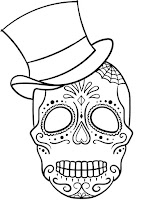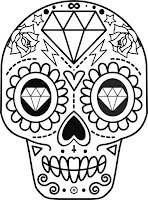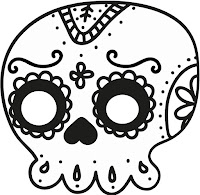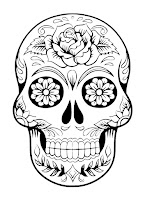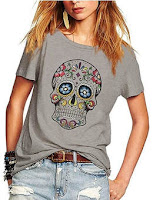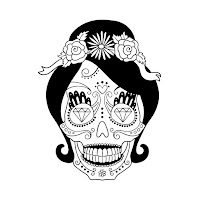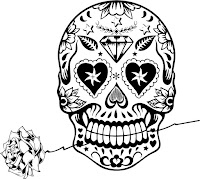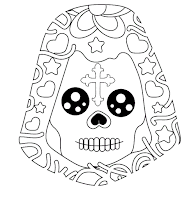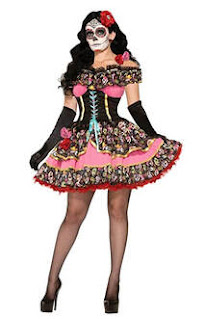Coloring pages of sugar skulls. The sugar skull is a major symbol of the Mexican holiday "Day of the Dead." In Spanish, the sugar skull is called Calavera. The Feast of the Day of the Dead is celebrated on the first and second days of November, at the same time that Christians celebrate All Saints 'Day followed by All Souls' Day. The holiday is celebrated on the Latin continent and especially in Mexico, and also in the United States in places where there is a Mexican community. The belief that accompanies this holiday is that the souls of the deceased are coming these days to reunite with the loved ones left behind, eat with them and drink and celebrate with them. The sugar skull is an ornament made of sugar or clay in the shape of a skull that is decorated with flowers, beads, cobwebs, feathers, foil, etc.
Printable coloring pages for kids and adults, worksheets for kindergarten kids, preschoolers and low grades on many different topics, games and exercises on many subjects, mandalas, hobbies, gifts, greeting cards, animations and glitters, health and good life tips, beautiful and moving stories and sentences.
Showing posts with label Day of the dead. Show all posts
Showing posts with label Day of the dead. Show all posts
Sugar skulls Coloring Pages
During the Day of the Dead celebrations and also on Halloween, many people wear make-up in a style called "sugar skull".
Here you will find coloring pages of sugar skulls.
Below you will find sugar skulls coloring pages which you can paint for your enjoyment. Choose the coloring page of sugar skull you want to paint, print and paint for your enjoyment. To print the page you would like to color, click on page and then click Ctrl+P. Have fun!
Day of the Dead - November 1
Despite the scary and perhaps also depressing name, Day of the Dead (Spanish: Día de los Muertos, Día de los Difuntos or, Día de Muertos) is a day of happy and cheerful celebration celebrated with costumes, carnivals and dances.
Day of the Dead is a Mexican holiday dedicated to the memory of the fathers who passed away. It is celebrated on the first and second days of November, the day Christians celebrate Halloween (which comes after Halloween) and the day before all the souls of the Catholic Church.
The holiday is celebrated with a cheerful and happy carnival in Mexico and other places where there are large Mexican communities.
During the day it is customary to go to cemeteries and churches and bring the dead gifts such as bottles of tequila, candles and flowers. People come to the carnival in skeleton and mask costumes or make-up of creative skulls, walking around with dolls of the dead and dancing.
 |
| In the photo: a grave with gifts and candles |
Other countries that celebrate the Day of the Dead are the Philippines, Brazil and other countries in Latin America.
The origin of the holiday is the cultures of the original natives of the American continent (mistakenly referred to as "Indians") - the Aztec culture, the Mayan culture, the Porfercha, the Nahuel and the Totonak.
 |
| Painting: Large electric skull, by Mexican painter Jose Guadeloupe Posada |
In Aztec culture the Day of the Dead is celebrated in the ninth month of the Aztec calendar, starting in early August, for an entire month. The holiday is considered the feast of the goddess Miktakakiwadel, "Goddess of the Dead," during which ceremonies were held for the souls of the dead relatives.
When Mexico was conquered by the Spaniards in the 15th century, Christian missionaries worked to eradicate the pagan holiday, and did so by postponing the holiday and uniting it with the Catholic holiday, All Saints' Day, which was held on the first day of November.
November 1 is also World Vegan Day and Go Cook For Your Pets Day
Subscribe to:
Posts (Atom)
All rights reserved Ⓒ
The use of this website's content is for personal only. Do not copy and distribute in any other media. Use of the contents of this website without permission for purposes that have not been approved will result in legal actions.
